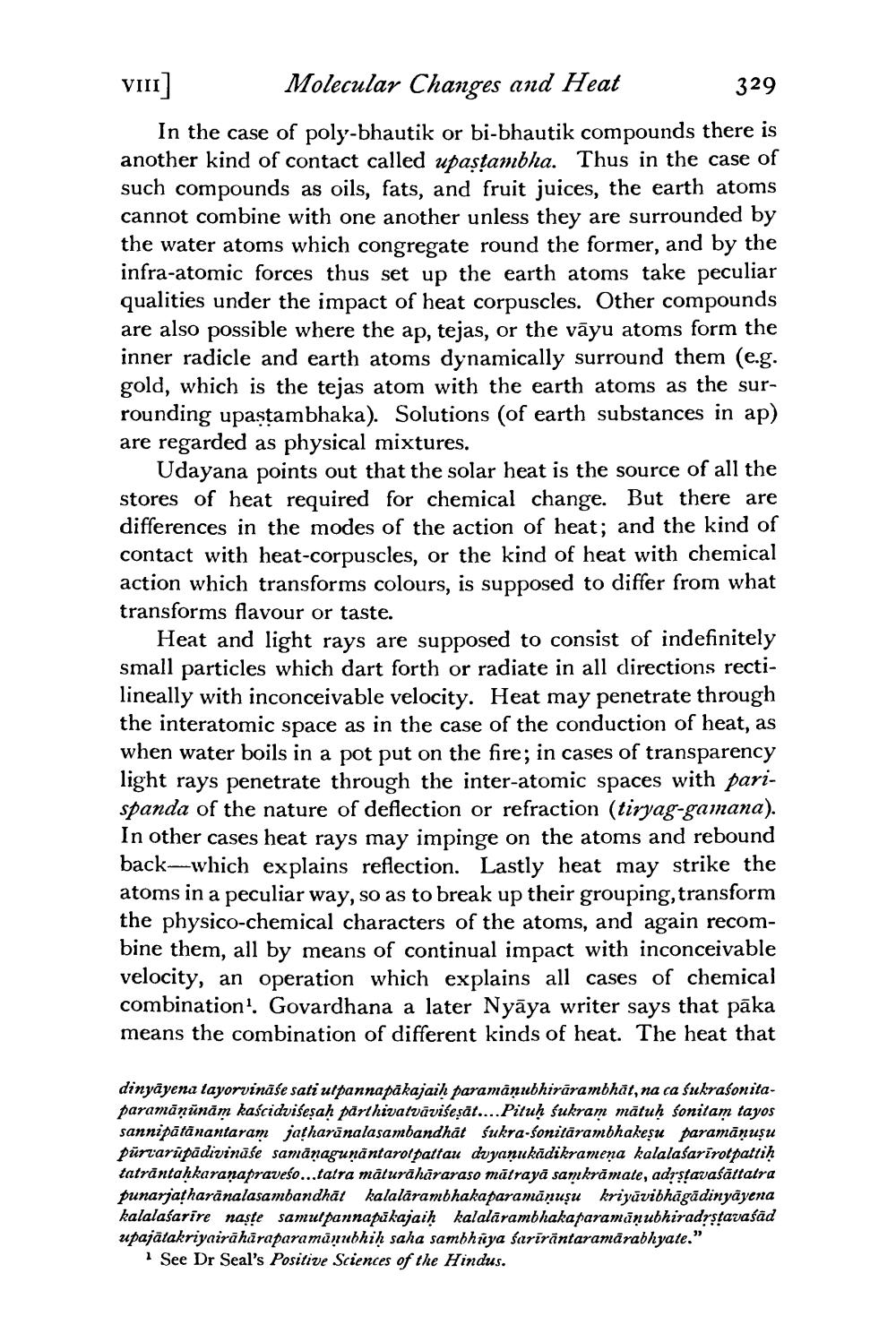________________
VIII]
Molecular Changes and Heat
329
In the case of poly-bhautik or bi-bhautik compounds there is another kind of contact called upaṣṭambha. Thus in the case of such compounds as oils, fats, and fruit juices, the earth atoms cannot combine with one another unless they are surrounded by the water atoms which congregate round the former, and by the infra-atomic forces thus set up the earth atoms take peculiar qualities under the impact of heat corpuscles. Other compounds are also possible where the ap, tejas, or the vayu atoms form the inner radicle and earth atoms dynamically surround them (e.g. gold, which is the tejas atom with the earth atoms as the surrounding upaṣṭambhaka). Solutions (of earth substances in ap) are regarded as physical mixtures.
Udayana points out that the solar heat is the source of all the stores of heat required for chemical change. But there are differences in the modes of the action of heat; and the kind of contact with heat-corpuscles, or the kind of heat with chemical action which transforms colours, is supposed to differ from what transforms flavour or taste.
Heat and light rays are supposed to consist of indefinitely small particles which dart forth or radiate in all directions rectilineally with inconceivable velocity. Heat may penetrate through the interatomic space as in the case of the conduction of heat, as when water boils in a pot put on the fire; in cases of transparency light rays penetrate through the inter-atomic spaces with parispanda of the nature of deflection or refraction (tiryag-gamana). In other cases heat rays may impinge on the atoms and rebound back-which explains reflection. Lastly heat may strike the atoms in a peculiar way, so as to break up their grouping, transform the physico-chemical characters of the atoms, and again recombine them, all by means of continual impact with inconceivable velocity, an operation which explains all cases of chemical combination'. Govardhana a later Nyaya writer says that paka means the combination of different kinds of heat. The heat that
dinyayena tayorvināśe sati utpannapākajaiḥ paramāṇubhirārambhāt, na ca śukraśonitaparamāņūnām kaścidviseṣaḥ pārthivatvāviseṣāt....Pituḥ śukram mātuḥ śonitam tayos sannipätänantaram jatharānalasambandhāt sukra-śonitārambhakeṣu paramāņuşu pūrvarūpādivināśe samānaguṇāntarotpattau dvyaṇukādikrameņa kalalasarirotpattiḥ tatrāntaḥkaraṇapraveso...tatra māturāhāraraso mātrayā samkrāmate, adṛṣṭavaśāttatra punarjaṭharānalasambandhāt kalalārambhakaparamāņuṣu kriyāvibhāgādinyāyena kalalaśarire naşte samutpannapākajaiḥ kalalarambhakaparamāṇubhiradṛṣṭavaśād upajätakriyairāhāraparamāṇubhiḥ saha sambhiya sarīrāntaramārabhyate."
1 See Dr Seal's Positive Sciences of the Hindus.




